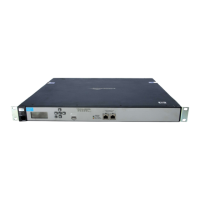Working with VLANs
Traffic flow for wireless users
7-7
Binding to a VSC that has Wireless mobility disabled
VSC type
Egress
network
in VSC
binding
Client
data
tunnel
User-assigned VLAN
is not assigned via
RADIUS or local user
accounts
User-assigned VLAN is assigned via RADIUS or local user accounts
User-assigned VLAN
exists on AP or controller
User-assigned VLAN does not exist
on AP or controller
VLAN ID VLAN name
Access-
controlled
Defined Active The Egress network
setting in the VSC
binding is ignored.
Traffic is sent to the
controller in the client
data tunnel. It exits the
controller on the egress
mapping defined on the
appropriate VSC.
The Egress network setting
in the VSC binding is ignored.
Traffic is sent to the
controller in the client data
tunnel. It exits the controller
on the user-assigned VLAN,
which overrides any egress
mapping defined on the
controller’s VSC.
User traffic
will never
reach its
destination
because the
user-
assigned
VLAN does
not match
any VLAN
IDs defined
on the AP or
controller.
The Egress network
setting in the VSC binding
is ignored.
Traffic is sent to the
controller in the client
data tunnel. It exits the
controller on the egress
mapping defined on the
appropriate VSC.
Disabled Traffic is sent on the AP
Ethernet port tagged
with the VLAN specified
by the Egress network
in the VSC binding.
The Egress network
VLAN must match the
ingress VLAN on the
bound VSC (or be
altered by a switch
between the AP and the
controller to do so)
otherwise traffic from
the AP will not reach
the controller.
Traffic exits the
controller on the egress
mapping defined on the
appropriate VSC.
Traffic is sent on the AP
Ethernet port tagged with the
VLAN specified by the Egress
network in the VSC binding.
The Egress network VLAN
must match the ingress VLAN
on the bound VSC (or be
altered by a switch between
the AP and the controller to
do so) otherwise traffic from
the AP will not reach the
controller.
Traffic exits the controller on
the user-assigned VLAN,
which overrides any egress
mapping defined on the
controller’s VSC.
Traffic is sent on the AP
Ethernet port tagged with
the VLAN specified by the
Egress network in the
VSC binding.
The Egress network VLAN
must match the ingress
VLAN on the bound VSC
(or be altered by a switch
between the AP and the
controller to do so)
otherwise traffic from the
AP will not reach the
controller.
Traffic exits the controller
on the egress mapping
defined on the appropriate
VSC.
Not
defined
Active Traffic is sent to the
controller in the client
data tunnel and is
mapped to a VSC on the
controller by SSID. It
exits the controller on
the egress mapping
defined on the
appropriate VSC.
Traffic is sent to the
controller in the client data
tunnel and is mapped to a
VSC on the controller by
SSID. It exits the controller
on the user-assigned VLAN,
which overrides any egress
mapping defined on the
controller’s VSC.
Traffic is sent to the
controller in the client
data tunnel and is mapped
to a VSC on the controller
by SSID. It exits the
controller on the egress
mapping defined on the
appropriate VSC.
Disabled Traffic is sent to the
controller untagged via
the AP Ethernet port
and is mapped to a VSC
on the controller by
SSID. It exits the
controller on the egress
mapping defined on the
appropriate VSC.
Traffic is sent to the
controller untagged via the
AP Ethernet port and is
mapped to a VSC on the
controller by SSID. It exits
the controller on the user-
assigned VLAN, which
overrides any egress mapping
defined on the controller’s
VSC.
Traffic is sent to the
controller untagged via
the AP Ethernet port and
is mapped to a VSC on the
controller by SSID. It exits
the controller on the
egress mapping defined
on the appropriate VSC.

